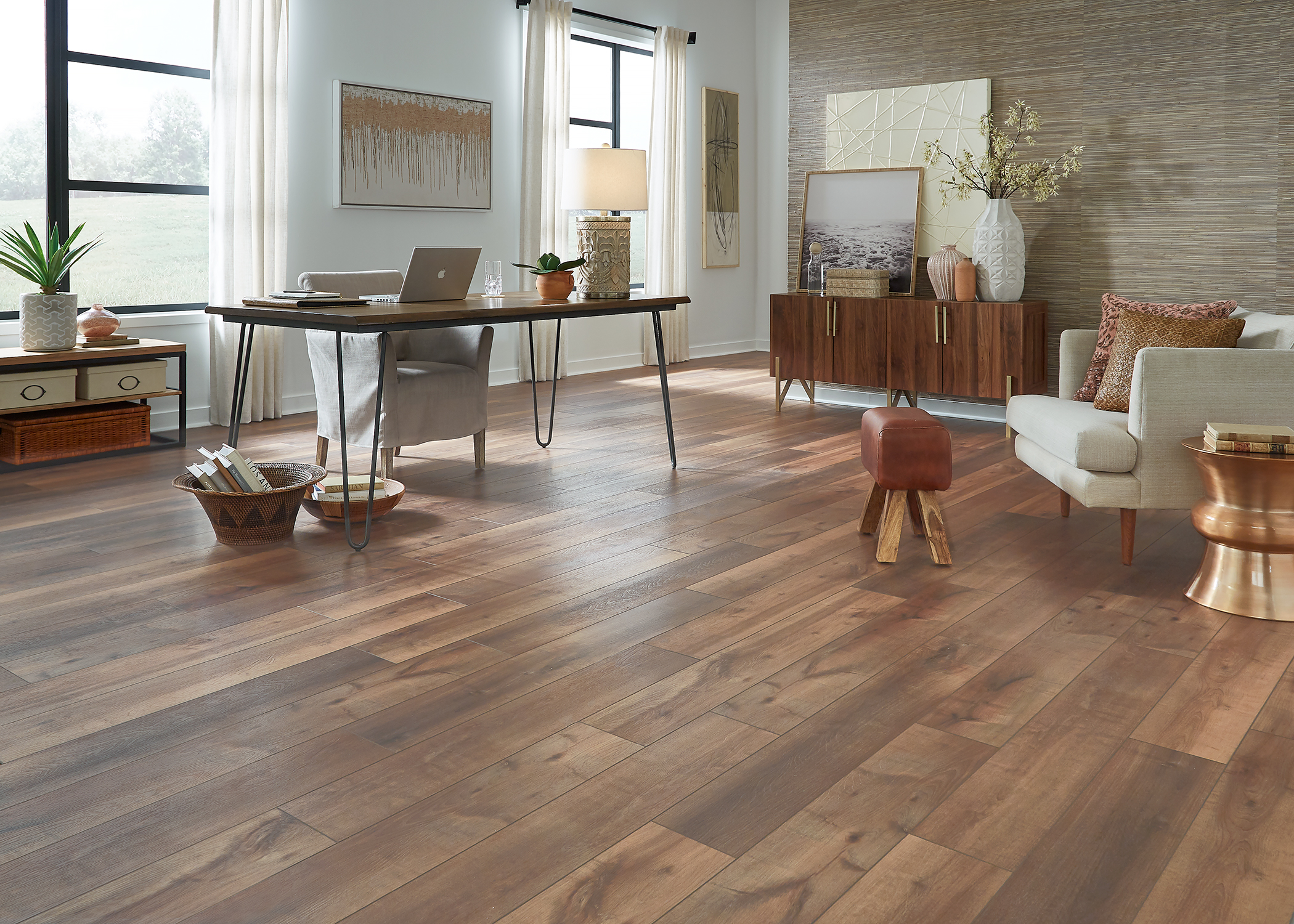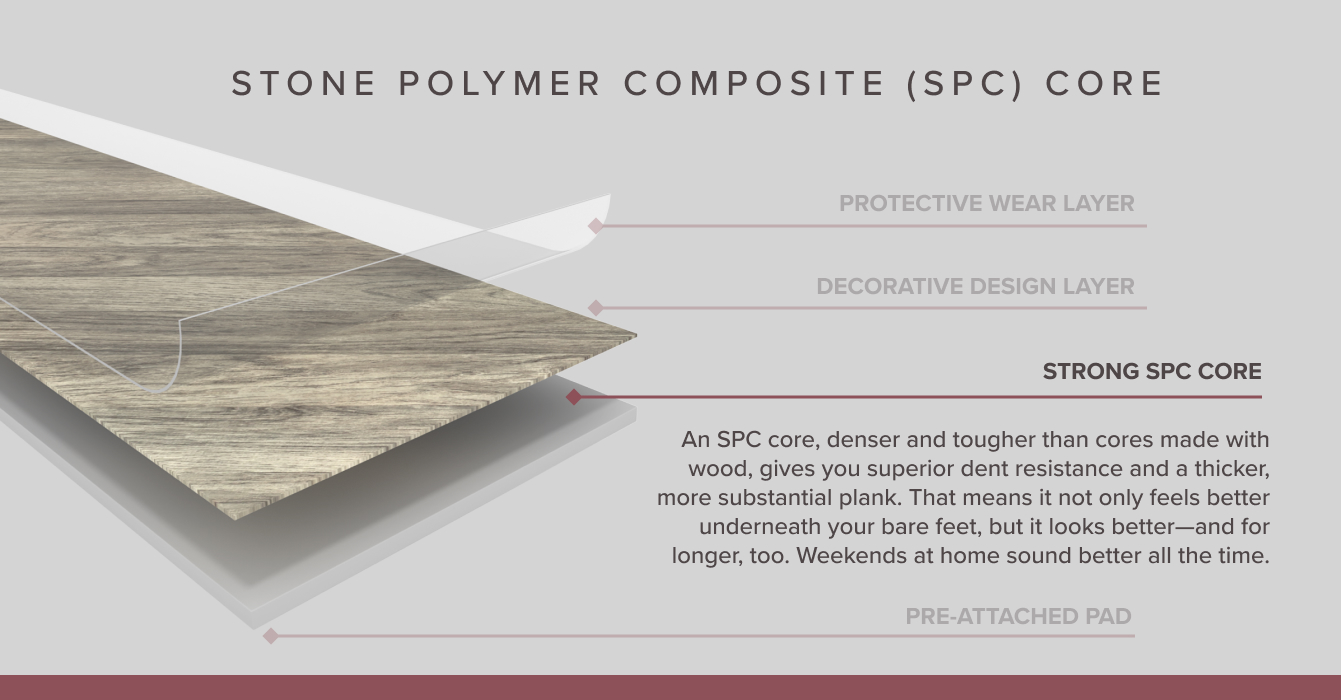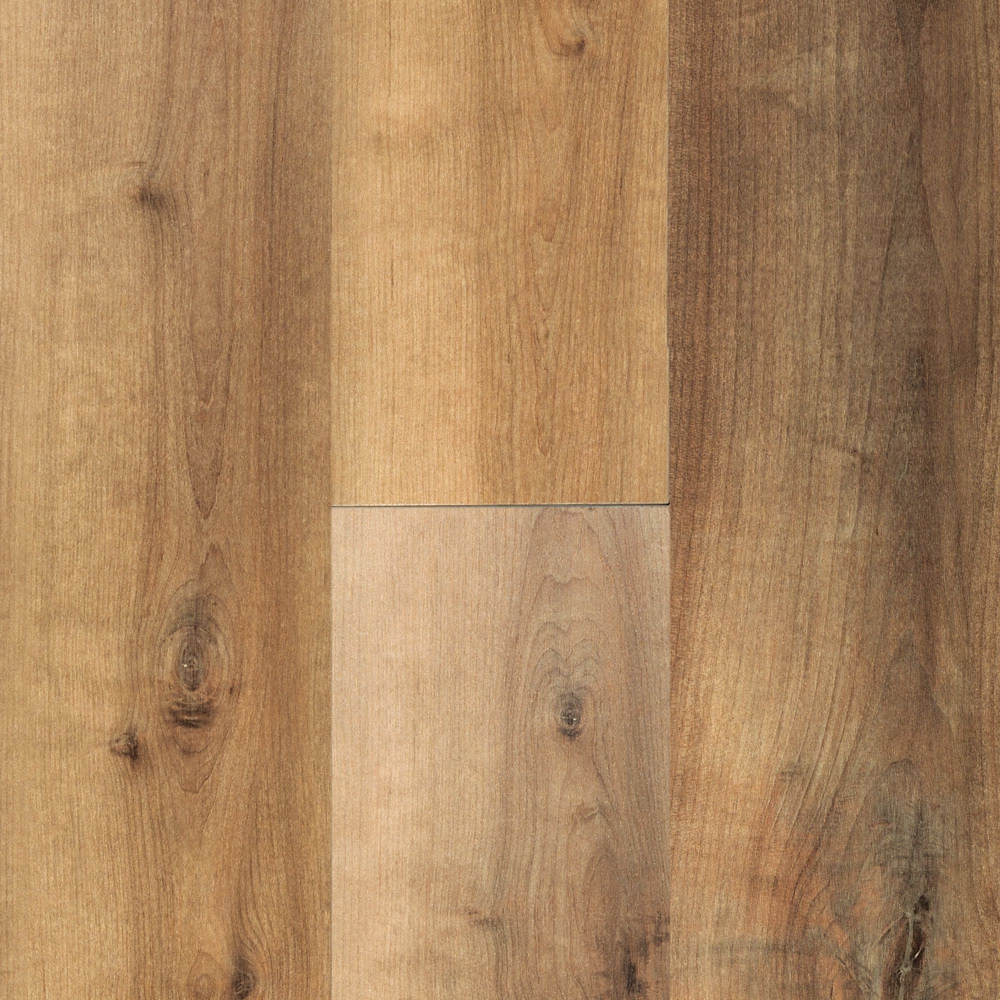- Home
- Education
- Flooring Basics
- What Is SPC Vinyl Plank?
What Is SPC Vinyl Plank?
SPC stands for stone-polymer composite. This composite material, made up of stone (calcium carbonate), polyvinyl acetate, polymer, and plasticizers, is used to create the strong core contained in rigid vinyl plank (RVP). Each vinyl flooring plank includes a wear layer, a decor layer, the core, and in most CoreLuxe floors, an attached pad. An SPC core improves the quality of your floors by providing greater sturdiness. So, when the kids are roughhousing in the living room, or the cat's chasing the dog around the kitchen, you won't have to worry so much about damage to your beautiful floors.
What's So Good About SPC?
Core makes a significant difference in the strength of your floor, how it performs, and how long it lasts. An SPC core, denser and tougher than cores made with wood, gives you superior dent resistance and a thicker, more substantial plank. That means it not only feels better underneath your bare feet, but it looks better—and for longer, too. Weekends at home sound better all the time.
Enhanced Dent Resistance for Long-Lasting Beauty
The wood and stone looks that vinyl offers imbue your home with a natural warmth and charm that you'll want to last forever. An SPC core helps your flooring retain that like-new look. The stone in the core provides a density and strength to repel impacts to the top layer, with the polymer offering substance and support. The result is rich, beautiful flooring with considerable staying power. So, if the cat knocks a book off a shelf or a bowl off the counter, you won't have to gasp so heavily at the thought of the damage done to your new floors.

The Stable Plank Makes It Last
Another benefit of an SPC core is the solidity and substance it gives your floor. This stability helps your floors to feel more secure under your feet, whether you're rushing around to get ready for work or lounging around on a lazy weekend. Not only does that greater thickness deliver a better-feeling floor, but it also gives you a longer-lasting floor. So, you go ahead and peel your eyes away from your floor for a while—it will be just as warm and beautiful in the morning.

Better Plank Stability No Matter the Weather
The stability of SPC vinyl planks, allows them to perform in areas that have a wide range of temperatures. Both shifts in temperature and in humidity can be all that's needed to cause wood-based boards to buckle or warp. But, stone isn't affected by the weather the same way, so an SPC-based core won't expand or contract as wood-based cores do. Instead, the stone-polymer core provides enhanced stability and substance, making your floors not only look better but also feel more secure underfoot. And this makes a difference, whether it's your baby's first steps or when you're pouring a glass of wine in the kitchen.
Installation Types
One of the things you'll appreciate most about vinyl flooring made with an SPC core is how easy it is to install, even for inexperienced do-it-yourselfers. But before you start installing your floor, you need to prepare both your planks and your subfloor.
Acclimation Is Essential
After your planks are delivered to your home, they need to get acclimated to your home's environment and ambient temperatures. While SPC cores create more stable planks, they will expand or contract based on changes in temperature. To prevent that, stack your cartons in the room for at least 24 hours. They should be kept between 60 and 80 degrees Fahrenheit. This will give the planks the necessary time to adjust to your home's climate. Once installed and with the correct expansion gap, a wider variation in temperature can be accommodated. While your planks acclimate, you can make sure your subfloor is ready.
Prep the Subfloor
Before you install any vinyl, you want to be sure your subfloor—the concrete or plywood surface beneath your floor—is clean, flat, and dry. Sweep away any dirt and debris to be sure your planks will lay flat. Make sure to install a moisture barrier over concrete to protect your flooring from alkalinity, and test your wood subfloor to ensure that moisture is not an issue that could lead to mold or mildew. Once you're sure the subfloor is ready, then you can start laying planks down.
Click-Float Makes Installation a Snap
At LL Flooring, our SPC core vinyl flooring uses a simple click-float installation technique. You simply lay a plank down, then lay the next. Push their ends together until they click and lock into place. Then, lay the next plank down and press together again until the ends click. Keep doing this until your floor is complete. Congratulations—your floor is ready for your active household.
Gluing Down Adds Security
In addition to clicking together your planks, you may wish to glue them down to your subfloor using an LL Flooring-approved adhesive. While gluing is a more complicated and challenging installation method, it can provide your floors with enhanced security. This can be an especially smart choice for commercial floors that will see significant foot traffic, as improved security can help extend the life of your floors.
Underlayment Makes a Difference
When you're planning an upgrade to your home's flooring, you want to make the right choices to ensure long-lasting beauty and performance. And often, it's the littlest improvements that can make the biggest difference. Underlayment is a thin layer of material, usually made of felt, fiber, foam, or rubber that can be laid between your subfloor and your planks. While it may seem like a minor thing you can take or leave, underlayment can make an outsized improvement to your floor's performance. Below, we check out the many ways underlayment can elevate your floor.
Protects Against Moisture
While RVP is waterproof, moisture can still cause damage to your flooring when it infiltrates from the subfloor. If you're concerned your concrete subfloor might contain moisture, installing a moisture barrier such as a 6mil poly or roll-cote, in addition to the underlayment, will help keep moisture and pH from reaching your new flooring.
Absorbs Sound for a More Peaceful Home
Another important benefit you'll receive when you install underlayment is greater sound absorption. The dense fibers and material of the underlayment dull the noise of shoes and boots thudding against the floor and transmitting to rooms below.
Gentler Underfoot for Happier Feet
Underlayment also adds padding to your floor that provides some “give” for when you're walking barefoot around the house. That's an improvement you'll really feel.
Other Accessories That Make Your RVP Flooring Stand Out
While your new RVP flooring with an SPC core adds style and vibrancy to your home, there are plenty of ways to complement and embellish your floors. And of course, proper floor care is essential to keep your floors clean and at their best. Check out some of the key ways to make your floors look even better and last even longer below.
Transitions and Moldings
Transitions and moldings give a professional look when joining two rooms, different flooring types (such as RVP and carpeting), and floors and walls. They help unify your home's interiors and add detail and interest.
Tools and Materials
When you have the right tools, it's much easier to do the job right. Installation kits, safe and effective adhesives, grout, and mortar can all make installing your flooring easier and quicker.
Floor Care
Caring for your RVP is simply a matter of periodic sweeping with a soft brush and an occasional wet mop for a more thorough cleaning. You can also use gentle cleaners, such as our Bellawood Cleaner, to remove more persistent stains or smudges.
Adhesives
If you plan on gluing down your planks, it's essential that you use an approved adhesive. This will ensure that your chosen glue will have plenty of sticking power so that your planks will properly adhere to the subfloor. And it will ensure that your adhesive won't contain chemicals that can damage your new planks.
Vents and Grills
For homes that have floor heaters or vents, the right grill or cover can not only protect your toes, but it can also add character and interest. You can find them in wood and stone looks to match your planks.
Now that you know all about how an RVP flooring with an SPC core can elevate your home, it's only a matter of picking out your own. There's no better time than the present to get started.



